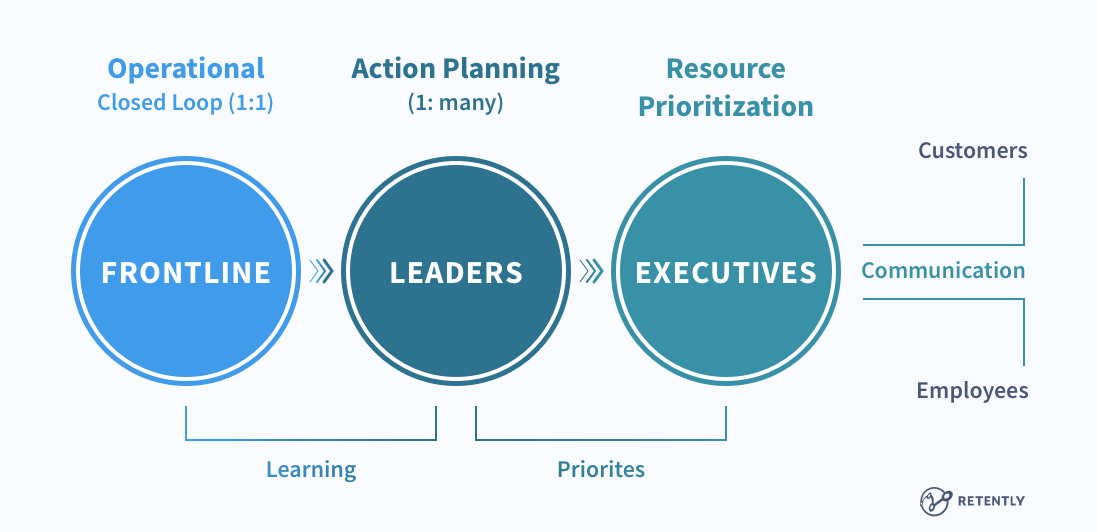With the advent of the Net Promoter Score®, capturing relevant feedback has never been easier. However, since the market landscape evolved – shifting the focus from survey data towards a more complex customer satisfaction management approach – the more advanced NPS2 paved its way.
If you are not familiar with NPS2, we will further explore this next-generation methodology, its main concepts and the factors that determined such Net Promoter Score evolution.
Before we get started, just keep in mind that NPS2 isn’t a term you’re likely to see a lot online. In fact, most uses of NPS® nowadays directly refer to NPS2. Customer experience management (CEM) is another way to refer to this methodology.
What Is NPS2?
There’s no exact NPS2 definition. The easiest way to think of it is as the evolution of the NPS methodology, which – over the years – changed from a data and research-based approach into a more integrated system that places great importance on the customer journey rather than just the survey data.
Thus, the topic is entering a new chapter with NPS2, becoming a driver of innovations for customer experience and getting more adjusted to the current market scene.
The 3 Pillars of NPS2
The shift toward a new methodology focused on understanding the customer experience and how it relates to running a business was mostly possible by having NPS2 revolve around 3 main pillars:
1. Market Dynamics
When NPS started being used, the online environment – especially social media – was nowhere close to reaching its full potential. Over the years, things have definitely changed.
NPS2 takes that fact into account and recognizes the kind of power social media can have over buyers’ intent nowadays. After all, many people would rather take their online peers’ word over that of someone who is actually an expert in a specific niche, meaning that companies must place more and more value on online customer reviews and recommendations.
Since these days many businesses use subscription-based models for their pricing plans more often, NPS2 places a lot of emphasis on customer lifetime value, too.
Customer experience also started having a significant influence on how market dynamics have evolved over the years. In fact, NPS2 is more focused on customer experience, as it has the power to set a company apart from its competition.
That’s no speculation – according to research, customer experience will overtake both price and product as the main brand differentiator.
2. Best Practice Learning
A customer experience program is successful when it focuses on the customer journey. Collecting customer feedback is no longer just about calculating a score, but also about making sure everybody in the company (regardless of position) understands the client’s perspective.
After all, if the feedback is not adopted at an enterprise level, it isn’t fully possible to continuously improve products/services to the point where customer satisfaction and experience reach high standards.
This way, all employee departments in your company can work together to ensure customer issues are fixed without escalation. Don’t forget – 89% of consumers get frustrated when they have to keep repeating their problems to numerous representatives.
Customer feedback can also be properly analyzed within the business context now, as it’s linked to other relevant business data.
3. Thought Leadership
Thought leadership revolves around the idea that it’s not enough for your employees just to perform customer support. They also need to feel engaged when doing it, so that customers can see that your employees enjoy interacting with them.
Engaging with Promoters is also an essential part of Thought Leadership, as they have the potential to become brand advocates if nurtured enough. One approach many business owners like to try is identifying Promoters, and following up with referral offers to get them to spread the word about their brand, and attract new potential clients.
Lastly, another aspect is that the customer must be the core of your business culture in order to achieve success in the market.
NPS vs NPS2 – What is the Difference?
NPS (be it the first version or the second one) is still about measuring, managing, and improving consumer loyalty.
However, a newer, more holistic approach is used for handling customer satisfaction with NPS2. Also, the elements used as metrics in the NPS methodology have changed too.
Here’s an overview of what we mean:
The Focus Is No Longer on the NPS Score
The shift is now towards focusing on the customer journey and using the score just for guidance. After all, if you are only fixed on the score itself, you end up placing restrictions on the actions you can take.
Also, the idea is to monitor the entire customer journey – not just parts of it. It’s the only way to ensure you’re always focusing on offering the best customer experience during each stage of the customer lifecycle.
This is something we were really happy to hear about. We’ve actually said this numerous times: The NPS score is more than just a number. It can be volatile, and you need to focus on multiple aspects (like the margin of error, the response rate you get, and the number of people who respond – just to name a few examples).
Relevant Data Comes Not Only from Surveys
Understanding customer needs is vital to ensure growth and extend customer lifetime, and the emerging variety of data sources is helpful in responding to this challenge. While NPS surveys offer great insights into how your brand and services or products are perceived, there is much more to explore.
NPS2 expands to more data sources, from social feedback to operational data, aiming at a comprehensive perception of the customer journey. By looking into different info sets, the new methodology tends to effectively embrace this data diversity and drive continuous improvements in every business aspect.
Here are some examples of additional data sources NPS2 takes into consideration:
- Insights captured during conversations with clients
- Unstructured feedback (essentially, feedback customers leave on social media)
- Operational data (helpdesk, billing and accounting data, etc.)
The Emphasis Is No Longer Only on Detractor Recovery
Instead, the idea is to focus more on engaging and nurturing Promoters. While it’s always a good idea to make sure your Detractor number isn’t too high, building a relationship with your Promoters can be more beneficial in the long run.
After all, they are the people who aren’t just recurring customers. They are also the ones who promote your brand online – whether it’s when they make an online post, tell their friends and family about your products/services, or just mention your brand in a comment.
How sure are we about that? Well, keep in mind that 72% of consumers will share a positive experience they had with a brand with 6 or more people, meaning your Promoters are likely to do that.
Basically, they help your company acquire new customers – ones who already view your brand in a positive way thanks to your Promoters.
And please note — NPS2 does not promote the idea of not bothering with Detractor recovery at all. Naturally, it’s important to do that, but focusing only on that is not a good approach.
Measuring Customer Data Must Be a Continuous, Integrated Process
It’s no longer considered enough to perform a one-time analysis of the data you gain from your NPS surveys. NPS2 takes it to the next level by saying that a real change in customer satisfaction, experience, and loyalty only takes place when customer data is part of a daily flow of information.
When a process like that can be fully integrated into your business and is performed alongside well-timed NPS surveys (during different customer lifecycle stages), that is when you are able to gather sufficient relevant info to make a meaningful change that will impact the customer experience journey.
Moving from Fragmentation to Integration
Satmetrix noticed that in the early years of NPS, many companies went overboard, and started measuring the NPS score wherever they could. In turn, that only resulted in fragmented pieces of data.
NPS2 aims to combine all data crumbles into one integrated system, providing companies with the framework they need to better understand and address the customer experience.
Emphasising Information Consumption Over Data Collection
For NPS to be truly efficient, all employees and departments in a company should get access to the customer data collected by these surveys.
NPS2 addresses the fact that you need to spend more time on finding ways to make the gathered feedback easier to consume for your employees than on practices to collect it.
The idea is to use engaging formats to get the data across to your employees to ensure they will all interact with it. A good example of that would be a company newsletter that displays all the data through infographics or videos, as visual content is generally more engaging than plain text.
Promoters Shouldn’t Be Left to Stagnate
This goes hand in hand with what we discussed above regarding Detractor recovery. Since Promoters are so valuable, you should never miss an opportunity to engage them.
The more you interact with Promoters and nurture their loyalty, the more likely they will become brand advocates, and start helping your brand to acquire new customers.
The Core Topics of NPS2
NPS2 revolves around 4 main core topics. Satmetrix recommends focusing on all of them to ensure your business gets the most out of NPS2.
1. Measurement Framework
As we’ve already mentioned when discussing the 3 Pillars, the focus must shift to the customer journey. The NPS2 approach is to think about everything in the context of the customer journey and start working on a measurement framework that reflects that. Your starting point should no longer be choosing where to deploy NPS surveys, but the customer journey itself.
And please remember – it’s not about the customer journey as a whole, but about each stage in its lifecycle.
A good idea would be to place more emphasis on cross-checking transactional data with customer relationship surveys to identify profitable opportunities to drive consumer loyalty.
2. Actionable Insight
While NPS surveys can help you gather tons of useful data, you can’t really act on it if only a few people in your company know about it or understand it.
The idea is that to drive meaningful action, you need to deliver actionable insights to all your employees. And those insights must be in a format that resonates with the various positions in your company.
According to Satmetrix, employees will usually fall into one of the 3 categories:
- Frontline Employees – They are the ones who must improve customer retention. Since they directly interact with your clients, you need to offer them complete, easy access to individual comments.
- Management Employees – Mainly responsible for customer experience, they need to know the exact factors that drive customer engagement, as well as insights regarding employee performance, and how it relates to those factors.
- Executives – Focused on profitable growth, they are the ones who should foresee trends across different market segments and ensure the strategic development. Executives must also understand the financial link between the company’s growth and NPS data.
3. Smart Loops
While the standard NPS closed loops can do wonders for winning back Detractors, NPS2 takes closed loops to the next level through smart loops, which also focus on Passives and Promoters to build and strengthen customer relationships.
Besides turning loyal clients into brand ambassadors and dissatisfied ones into brand advocates, smart loops can also help you innovate the customer experience by analyzing the stages in the customer journey where clients are “handed off” from one department to another.

The first smart loop involves the Frontline employees when customer feedback is offered, and customer support acts on it. Now, the feedback can be leveraged to learn more about the root cause and find solutions that strengthen customer relationships.
The second smart loop involves the company’s Leadership level, which must focus on improving the overall customer experience by relying on customer satisfaction data.
The third smart loop takes place at the Executive level. The emphasis is laid on developing a quality communication strategy between clients and employees, and on closely analyzing the numerous customer categories (so that you can offer them exactly what they want). Resource planning can also be handled in this loop, as long as the company’s Promoter distribution is taken into consideration.
4. Enterprise Adoption
Basically, you need to incorporate NPS2 into customer satisfaction management. To do that, you will first need a strategy that doesn’t solely rely on surveys, but on information consumption and distribution too.
All organization levels of your company must have access to relevant customer data, and each department must know its roles and goals in relation to that. Ideally, all processes should be integrated into a system for customer experience management (CEM).
Looking to Properly Integrate NPS with Your Business Strategy?
Whether you’re just looking to run a standard NPS survey or get access to relevant, in-depth customer feedback and analytics, we’ve got you covered. Retently is the perfect NPS software for the job – easy to use, completely customizable, and it comes with automated features, too.
We’ll send the surveys on your behalf, our AI systems will automatically analyze and segment your customer feedback, and we will escalate any critical issues back back to you + assist you with finding proper solutions.



































 Greg Raileanu
Greg Raileanu 

 Christina Sol
Christina Sol 


